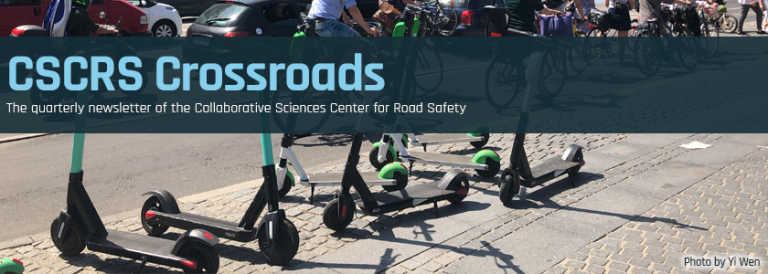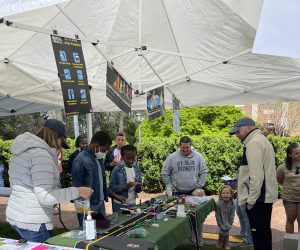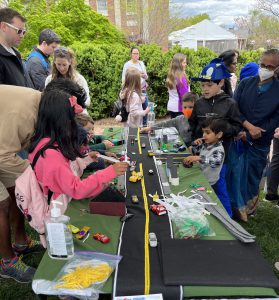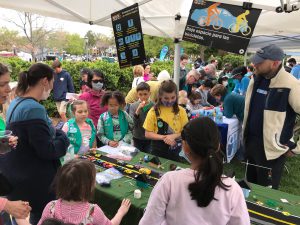CSCRS teaches kids about designing safe roads during the NC Science Festival
As part of the annual 2022 North Carolina Science Festival, a month-long celebration of science throughout the Tar Heel State, CSCRS presented two activities designed to engage young students in imagining what it takes to make roads safe.
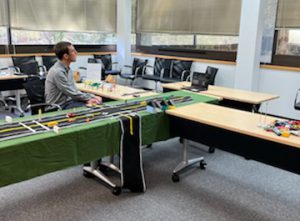
Seth LaJeunesse directs kids through the virtual road demo.
On April 6, 2022, CSCRS researcher Seth LaJeunesse, UNC Highway Safety Research Center (HSRC), guided approximately 70 North Carolina middle school students through a virtual safe road demonstration. A teacher from one participating class shared, “They were so incredibly excited when they found out that they would be able to talk with ‘real engineers’ (as they put it), and they absolutely loved seeing you implement their suggestions. I had several students tell me that they now wanted to explore engineering as a career.”
Then on April 9, 2022, several CSCRS colleagues hosted a table at the UNC Science Expo, an in-person event coordinated by the UNC Morehead Planetarium & Science Center. The Expo was held on the UNC campus with dozens of booths featuring family-focused science activities. At the CSCRS exhibit, kids were invited to use miniature road design features to plan a safe path to school along a busy street. Approximately 5,000 people attended the event this year.
Systems spotlight: CSCRS research featured in UTC newsletter and more
CSCRS’s extensive work connecting Vision Zero with the Safe System approach was highlighted in the April 2022 edition of the U.S. Department of Transportation (USDOT) UTC Spotlight newsletter. The article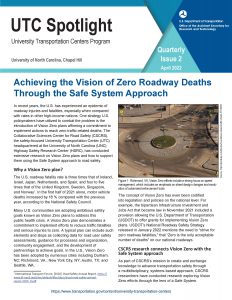 “Achieving the Vision of Zero Roadway Deaths Through the Safe System Approach” explains the Vision Zero concept as a way to address the steady increase in roadway fatalities and injuries over the years.
“Achieving the Vision of Zero Roadway Deaths Through the Safe System Approach” explains the Vision Zero concept as a way to address the steady increase in roadway fatalities and injuries over the years.
Other recent Safe System developments of note include:
- In March 2022, the USDOT Federal Highway Administration released “Moving to a Complete Streets Design Model: A Report to Congress on Opportunities and Challenges.” The report’s conclusion states, “Safety is DOT’s top priority, and the successful implementation of a Safe System approach, including safe accommodations for all modes and all users on roadways throughout the Nation, is central to the efforts that DOT is making to meet roadway safety goals.”
- In January 2022, USDOT released the National Roadway Safety Strategy, which promotes the Safe System approach. The document’s opening letter from Secretary Pete Buttigieg states, “At the core of this strategy is a Department-wide adoption of the Safe System Approach, which focuses on five key objectives: safer people, safer roads, safer vehicles, safer speeds, and post-crash care. We will launch new programs, coordinate and improve existing programs, and adopt a foundational set of principles to guide this strategy.”
CSCRS continues work on new codes for micromobility-related injury surveillance
In an effort related to the CSCRS project “Understanding micromobility safety behavior and standardizing safety metrics for transportation system integration,” CSCRS team members from HSRC, the University of Tennessee, Knoxville (UTK), and the University of California, Berkeley, working with other partner organizations, developed a proposal to add codes to the International Classification of Diseases, Tenth Revision, Clinical Modification (ICD-10-CM) describing injuries related to e-bikes. This proposal was approved by the ICD-10 Coordination and Maintenance Committee in late 2021, and the e-bike-specific codes will be incorporated into the FY2023 version of ICD-10-CM (expected to be released in October 2022).
CSCRS team members were also part of a group that was previously successful in getting a series of ICD-10-CM codes for categorizing injuries related to e-scooters and other micromobility devices officially adopted as part of the FY2021 version of ICD-10-CM. The poster “Micromobility Modes, New Codes!” was created to aid healthcare professionals in accurately applying these codes in medical facilities.
April CSCRS online seminar to discuss methods for advancing safety education
The next session in CSCRS’s Research to Practice Bytes series will be “Creative placemaking techniques to advance traffic safety,” to be held on April 27, 2022. The session will be presented by CSCRS Associate Director Eric Dumbaugh, Florida Atlantic University (FAU). Registration is available now, and more details on the session will be announced soon.
Recordings and slide decks from precious webinars are available on the series website.
Education and professional development: CSCRS spotlights multiple learning opportunities
CSCRS continues to provide and participate in a variety of learning activities, including:
- CSCRS researchers will present sessions as part of the NC Traffic Safety Conference in August 2022:
- Katie Harmon, HSRC, will present “Hidden Injuries, Missing Bicyclists, & Other Lessons Learned from the NC Crash Injury Surveillance System (NC-CISS).”
- Seth LaJeunesse will present “Traffic Crashes as Seen On TV: An Opportunity to Reshape the Dialogue Around Road User Injury.”
- On April 22 and 23, 2022, UNC’s Department of City and Regional Planning (DCRP) will host the workshop “Flipping the script on traffic violence” with Tom Flood of Rovélo Creative. The event will incorporate walking and biking tours in Chapel Hill and Carrboro, NC, and an interactive exercise to craft effective messages about road safety challenges facing pedestrians and bicyclists.
- Tab Combs, UNC DCRP, presented “New dog, old trick? How process and public engagement shaped pandemic-era mobility planning” on April 14, 2022, during a session of the Urban Affairs Association Annual Conference.
- On April 12, 2022, CSCRS researchers Eric Dumbaugh and Seth LaJeunesse participated in the online panel discussion “Acting with Urgency: What does ‘Safer People’ mean?” hosted by partner organization Vision Zero Network.
- Multiple CSCRS researchers and partners co-presented during the March 2022 Lifesavers conference in Chicago:
- Becky Naumann, UNC Injury Prevention Research Center, presented during the sessions “A Safe System Approach: In the Real World” and “Young at Heart: Motor Vehicle Safety in Our Golden Years.”
- Nancy Pullen-Seufert, HSRC, presented during “A Safe System Approach to Protecting Child Road Users.”
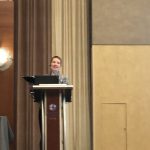
Nancy Pullen-Seufert at Lifesavers
- Nandi Taylor, Graduate Research Assistant for the UNC Gillings School of Global Public Health, and CSCRS Advisory Board member Nadia Anderson, Director, Federal Affairs, INRIX, co-presented during “One Size Does Not Fit All: Transportation Equity in the 21st Century.”
- Jennifer Homendy, Chair of the National Transportation Safety Board and frequent CSCRS collaborator, delivered the keynote address.
- On February 24, 2022, a video produced by CSCRS researchers at UTK was featured in the first USDOT UTC “Research, Development, and Technology Forum on AI in Transportation.” Subhadeep Chakraborty and Asad Khattak of UTK showcased their CSCRS work related to artificial intelligence. The full forum video is available here.
Other CSCRS highlights
A quick rundown of additional recent CSCRS activities:
- CSCRS Associate Director Miroslav Pajic, Duke University, was interviewed about research on a specific type of attack that can fool LiDAR systems on autonomous vehicles for the March 14, 2022, article “WARNING: Objects in Driverless Car Sensors May Be Closer Than They Appear.”
- CSCRS Director Laura Sandt, HSRC, was interviewed about Chapel Hill, NC, crashes involving pedestrians for the article “Keeping pedestrians safe” featured in the March 2, 2022, edition of UNC’s The Well.
- UTK researchers authored the recently published article “Toward better measurement of traffic injuries – Comparison of anatomical injury measures in predicting the clinical outcomes in motorcycle crashes” in the February 2022 issue of the Journal of Safety Research.
- Researchers working on CSCRS project “Strengthening existing and facilitating new Vision Zero plans” prepared these brief summaries based on sections of the “Guide to Developing a Vision Zero Plan” that help communities better apply the principles of Vision Zero to their specific context. These summaries and other Safe Systems resources are available in the Creating Safer Systems and Healthier Communities: Resource Hub.
CSCRS bookshelf
“Disabled People Are Tired: Public Health and Ableism,” Christine Mitchell, Disability Visibility Project, March 7, 2022
By Kristin Podsiad
Kristin Podsiad is pursuing a joint master’s degree with UNC’s DCRP and the UNC Gillings School of Global Public Health.
The inescapable COVID-19 pandemic has brought transportation to the forefront of everyday discourse, from shortages in the transportation workforce to reimagining cities through the expanded bike and pedestrian infrastructure. As Christine Mitchell points out in the blog post “Disabled People Are Tired: Public Health and Ableism,” everyone is tired. Mitchell swiftly reminds the reader that the impacts of COVID are not equal. People with disabilities have even more reason to be tired. This piece asserts that “we must listen to and learn from disabled people in a consistent, respectful, and sustained way and we must center disabled people in our policies and practices, throughout the pandemic and beyond.” While Mitchell is pointedly speaking to the field of public health in this piece, the applicability and the calls to action are just as salient to transportation professionals. As we design, research, and advocate we must address historic and structural marginalization, ableism, and racism to attain health equity. This read is an opportunity to listen and then take action by centering people with disabilities in transportation policies and practices; I recommend it to everyone.
CSCRS Jobs Board available for job seekers and posters
CSCRS developed the CSCRS Jobs Board for employment and other opportunities in the transportation field. If you are looking for a new job, visit the Jobs Board today! If you have a transportation-related job to post, email info@roadsafety.unc.edu.
CSCRS Crossroads newsletters are archived here.



